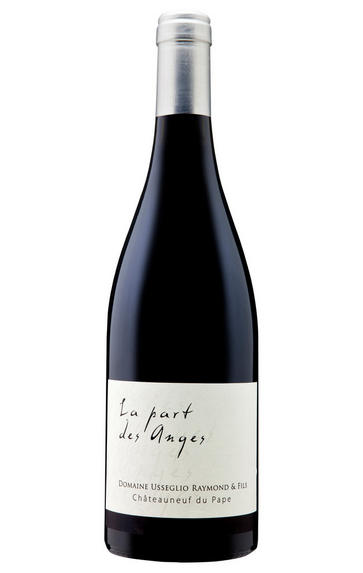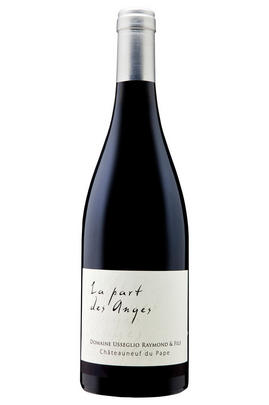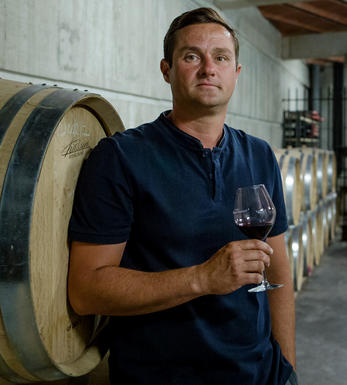
2016 Châteauneuf-du-Pape, La Part des Anges, Domaine Raymond Usseglio & Fils, Rhône

Critics reviews
Joe Czerwinski - 31/08/2018
About this WINE

Domaine Raymond Usseglio
This third-generation family domaine, of Italian origin, is today run by Raymond’s son, Stéphane Usseglio. The estate counts 24-hectares in Châteauneuf-du-Pape, all of which have been managed biodynamically since 2011. Their vineyards are divided equally between the galet-strewn parcels around Orange, the sandy soils of Courthézon and the alluvial, clay soils of the Crau plateau and the village of Bédarrides. Stéphane continues to innovate, using small, new oak barrels alongside the traditional foudres, as well as experimenting with concrete and terracotta amphorae of varying shapes and sizes. These winemaking techniques enhance the characteristics of each grape variety, carefully highlighting the particularities of each.
Stéphane’s 2021 wines are a great success, albeit 20-25% down in volume against their average yield. The wines show their trademark power and structure; but as we’ve seen with other producers, they also have lower levels of alcohol and higher acidity than the last two vintages. While this freshness makes them more approachable in youth than in some years, their structure will ensure they are nonetheless worthy of cellar ageing. They are wines to return to throughout their ageing process.

Châteauneuf-du-Pape
The most celebrated village of the Southern Rhône, Châteauneuf-du-Pape is the birthplace of the now indispensable French Appellation d’Origine Contrôlée system – imperfect though it may be. Compared to the Northern Rhône, the vineyards here are relatively flat and often feature the iconic galet pebbles – the precise benefits of which are a source of much debate. Minimum alcohol levels required by the AOC are the highest in France, but at 12.5% it is well below the natural generosity of Grenache, which only achieves its full aromatic potential when it is fully ripe and laden with the resultant high sugars. Syrah and Mourvèdre contribute the other defining elements in the blend, adding pepper, savoury spice and structure to the decadent Grenache. There are a further 10 permitted red grape varieties which can be used to adjust the “seasoning”. Of the five white varieties permitted, it is Grenache Noir’s sibling – predictably perhaps – Grenache Blanc, which dominates, though Roussanne shows a great deal of promise when handled well, notably at Château de Beaucastel.

Southern Rhône Blend
The vast majority of wines from the Southern Rhône are blends. There are 5 main black varieties, although others are used and the most famous wine of the region, Châteauneuf du Pape, can be made from as many as 13 different varieties. Grenache is the most important grape in the southern Rhône - it contributes alcohol, warmth and gentle juicy fruit and is an ideal base wine in the blend. Plantings of Syrah in the southern Rhône have risen dramatically in the last decade and it is an increasingly important component in blends. It rarely attains the heights that it does in the North but adds colour, backbone, tannins and soft ripe fruit to the blend.
The much-maligned Carignan has been on the retreat recently but is still included in many blends - the best old vines can add colour, body and spicy fruits. Cinsault is also backtracking but, if yields are restricted, can produce moderately well-coloured wines adding pleasant-light fruit to red and rosé blends. Finally, Mourvèdre, a grape from Bandol on the Mediterranean coast, has recently become an increasingly significant component of Southern Rhône blends - it often struggles to ripen fully but can add acidity, ripe spicy berry fruits and hints of tobacco to blends.


Buying options
Add to wishlist
Description
The Part des Anges was, despite the intense
competition, probably my favourite 2016 of the whole
16-day trip. With 70 percent Mourvèdre matured in 70
percent new oak, this is disarmingly fresh and open, its
savoury precursors locked in a pure expression of dark
dark fruit, its tannic potential completely harnessed
by the intensity of the fruit. Spicy, rich, gourmand and
utterly beguiling. A real triumph, and the smile on
Stephane’s face shows that he is rather proud of this
cuvée, with good reason. Drink 2022-2030.
Simon Field MW, Wine Buyer
wine at a glance
Delivery and quality guarantee